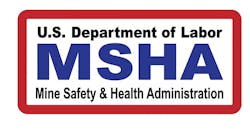A three-judge panel of the U.S. Court of Appeals for the District of Columbia overturned a Mine Safety and Health Administration’s (MSHA) rule issued last year governing examination of mines before miners begin work, declaring that it would make working conditions less safe than they were under the rule it replaced.
The panel of judges agreed with several unions who had challenged the 2018 rule, asserting that it violated the 1977 Federal Mine Safety and Health Act, which prohibits MSHA from issuing any regulation that would reduce the protection afforded miners by an existing mandatory health or safety standard.
The rule had gone into effect on June 2, 2018, and included two major changes to a different rule that MSHA had issued in 2017. Under the newer rule, examinations could occur before or at the same time that miners begin work, and mine operators could exclude from their records any adverse conditions found during the examination that were promptly corrected.
Like so much else that happens in Washington’s welter of agencies and their administrative admixture, the history of the rule is complicated (if not always alliterative). In this case, it all began in the dog days of summer in 2016, when the Obama administration MSHA issued a proposed rule that would replace the existing workplace examination standard applying to metal and nonmetal mines.
After the usual notice-and-comment period for a federal regulation, the final rule was published on January 23, 2017, and was supposed to take effect on May 23, 2017. However, the new Trump administration MSHA later chose to delay the new rule’s effective date until October 2, 2017, while the agency used that time to re-examine the standard.
The original iteration of the rule added the direction that workplace exams must take place before miners begin work and that operators “promptly” notify miners of adverse conditions found, record any such adverse conditions, and record the subsequent corrective action taken by the operators.
After the delay but before the 2017 rule could become effective, MSHA announced two substantive changes. One permitted workplace exams to occur either before work began or as miners began work. The second change exempted from the recordkeeping requirements any conditions that the mine operator promptly corrected. With those two changes, the 2017 rule became the “2018 rule.”
“MSHA explained that the ‘as work begins’ option would give operators more flexibility to schedule exams and be as protective of miners as the 2017 rule,” notes attorney Lauren M. Marino of the law firm of Ogletree Deakins. “Moreover, MSHA explained that the ‘promptly corrected hazards’ recordkeeping exception would incentivize operators to correct hazards immediately because, if a hazard was corrected, it need not be recorded.”
An immediate court challenge was filed by the United Steel, Paper and Forestry, Rubber, Manufacturing, Energy, Allied Industrial and Service Workers International Union, AFL-CIO/CLC, and the United Mine Workers of America International Union arguing that the 2018 amendment violated the 1977 Mine Act’s no-less-protection standard.
In vacating the 2018 amendment and reinstating the 2017 rule, the Appeals Court panel found that the 2018 changes did indeed violate the no-less-protection provision relative to the 2017 rule. The judges found that because it “does not allow for notification before exposure” which “allows miners to work in an area before the examination is completed, there is the likelihood that miners may be exposed to an adverse condition before it is discovered.”
The court rejected the agency’s assertion that the 2018 changes provided no less protection than the 2017 rule, and held that MSHA relied on a “non-existent notification-before-exposure duty” which cannot be reconciled with factual findings that MSHA made in support of the 2017 rule.
In addition, the judges rejected MSHA’s justification for the 2018 rule recordkeeping revision, stating MSHA had provided no basis for its conclusion that the supposed benefits will equal or exceed those stemming from the 2017 rule.
It is possible that MSHA could choose to appeal the panel decision—which was decided on a 2-to-1 vote—to the full DC Circuit. But even if it doesn’t, don’t expect the saga to end, point out attorneys Patrick Dennison and Arthur Wolfson of the Fisher Phillips law firm. A challenge to the 2017 rule that had been brought earlier by mine operators is currently pending in the Eleventh Circuit Court of Appeals. That challenge had been stayed pending the outcome of the unions’ challenge to the 2018 rule in the D.C. Circuit.
Margaret S. Lopez of Ogletree Deakins also observes that even if MSHA does seek further review of the Appeals Court panel decision, it is possible that the agency could choose to take other actions short of immediate enforcement of the 2017 rule.
“If MSHA follows the same process it did previously on implementing the workplace examination rule, mine operators could expect the agency to phase in enforcement over time, while providing operators further information on what will be required and time to adjust their workplace exam program to the new requirements,” she says.

